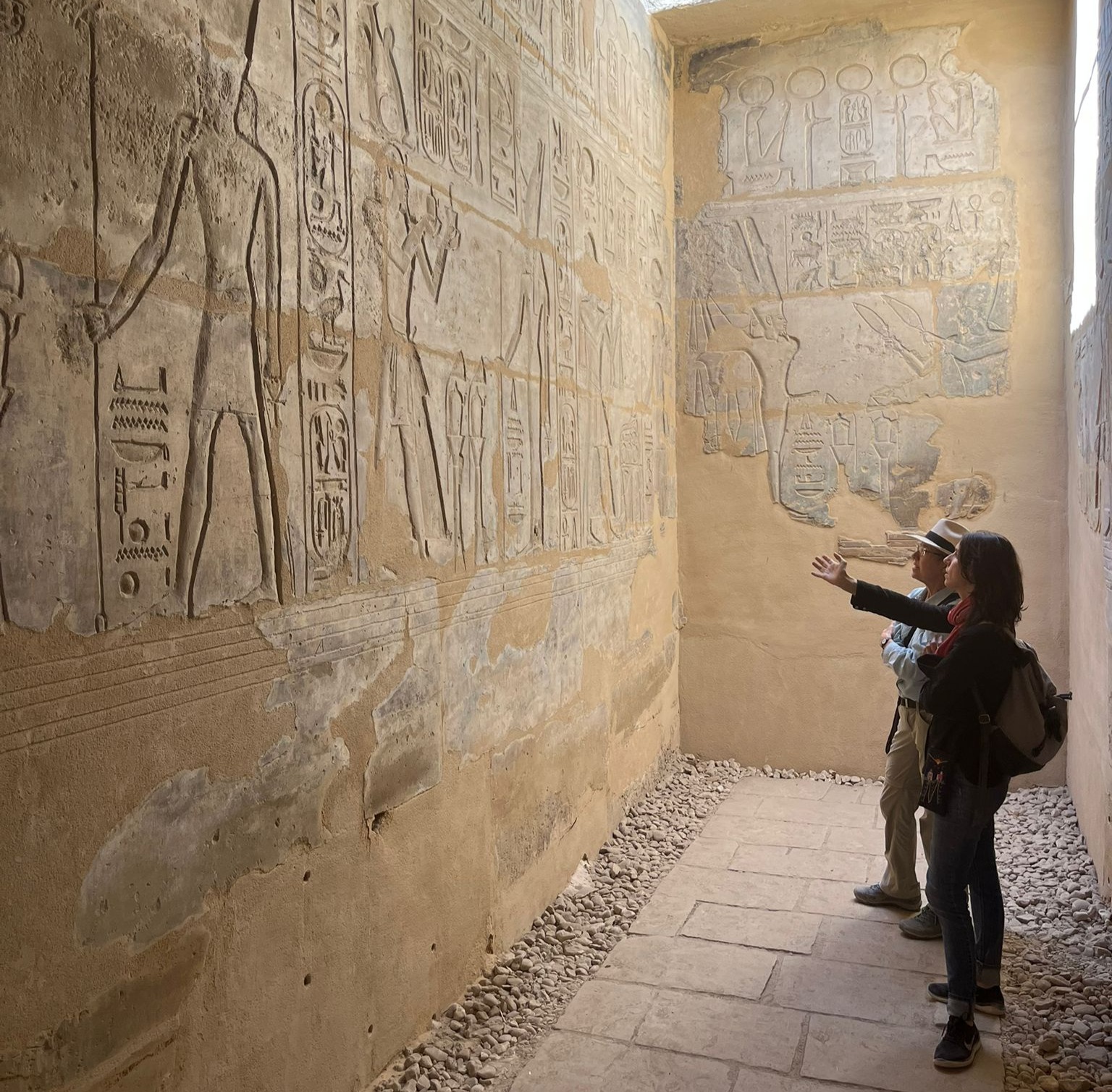News and events

Upcoming events
Rundle Foundation for Egyptian Archaeology Lecture
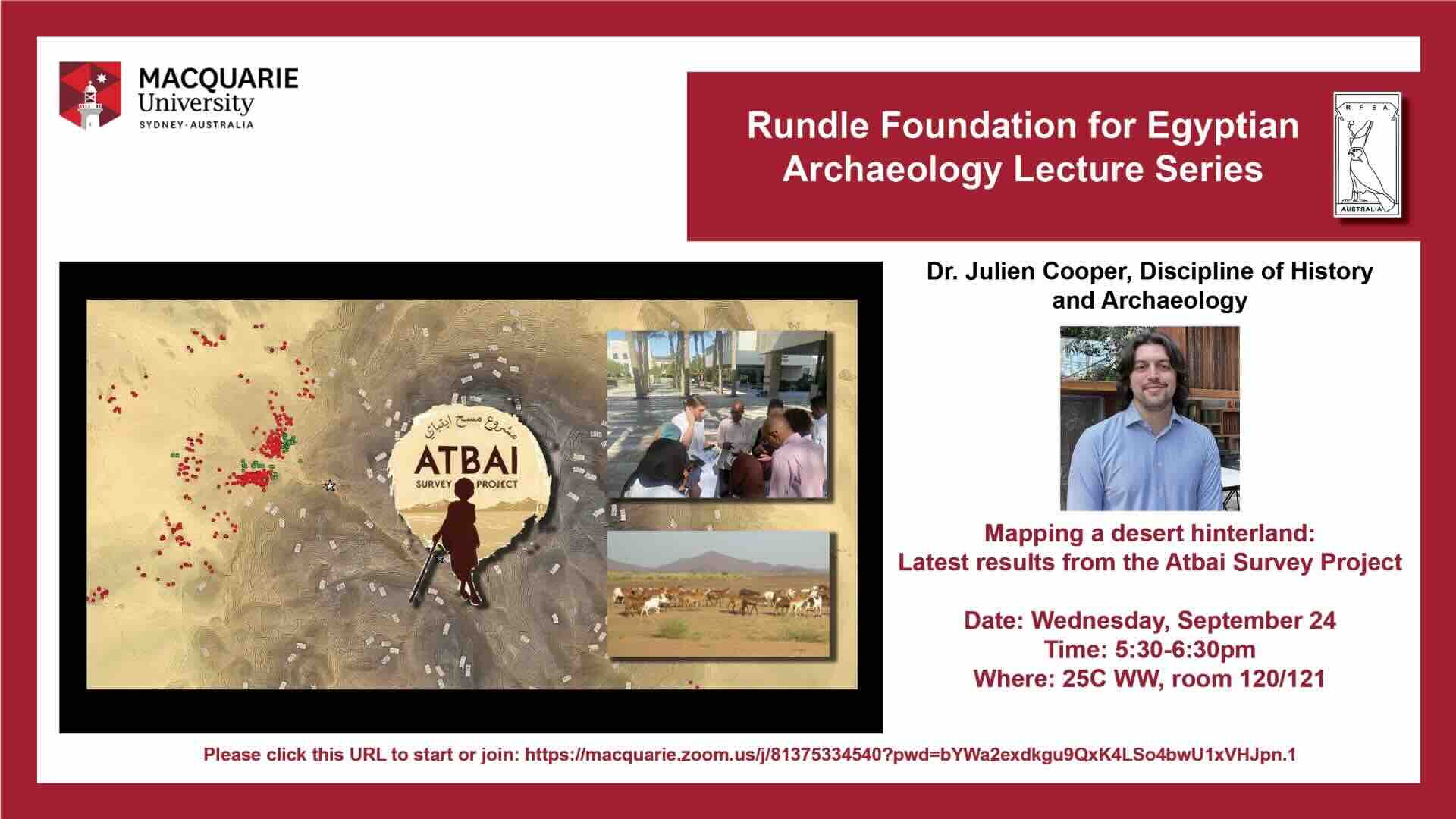
Please join us on Wednesday, September 24 for the next presentation in the 2025 Rundle Foundation for Egyptian Archaeology lecture series.
The paper, which is entitled, 'Mapping a desert hinterland: Latest results from the Atbai Survey Project', will be presented by Dr Julien Cooper, Discipline of History and Archaeology at Macquarie University.
Time: 5:30-6:30pm (refreshments from 5pm)
Where: 25C WW, room 120/121
Zoom: https://macquarie.zoom.us/j/81375334540?pwd=bYWa2exdkgu9QxK4LSo4bwU1xVHJpn.1
Abstract: The Eastern Desert of Sudan, the Atbai, is a vast landscape punctuated by ancient goldmines, nomadic settlements, and numerous tumuli. From Neolithic cattle burials to vast late antique cemetery fields, this presentation will highlight the discoveries of the first year of work mapping the region through remote sensing. Beyond this, the presentation while also provide an overview of the heritage challenges and outreach work to support the preservation of the archaeology of the region.
Past events
Annual conference
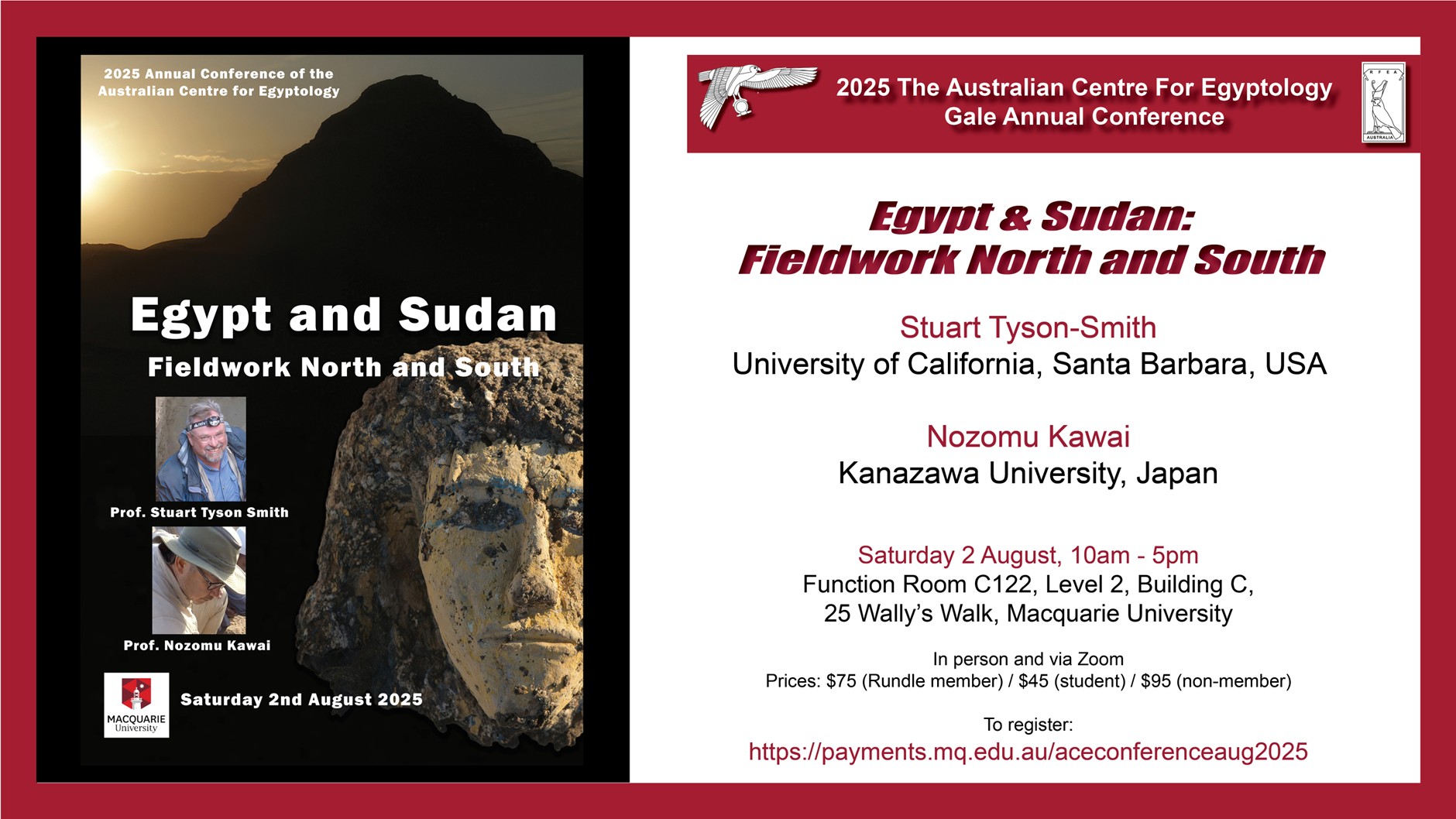
Please join us on Saturday, August 2 (10 am–5pm) for the 2025 annual conference of the Australian Centre for Egyptology focussing on “Egypt & Sudan: Fieldwork North and South”. This year our Gale Visiting Fellows are renowned international Egyptologists, Stuart Tyson Smith from the University of California Santa Barbara, USA, and Nozomu Kawai from University of Tsukuba, Japan. The event will be held in the Macquarie University Arts Precinct (25 Wally’s Walk, Building C: Function Centre) and will be offered both in-person and via Zoom. In-person attendance will include morning tea, lunch, and afternoon tea.
The lectures are as follows:
Professor Nozomu Kawai
'Exploring the Evolution of the Funerary Landscape at north Saqqara over Millennia'
'Japanese Excavations at the Lion's Hill at northwest Saqqara'
Professor Stuart Tyson Smith
'Through the Stargate: Receptions of Ancient Egypt in film'
'Death at Tombos: Egyptian-Nubian Entanglements during the New Kingdom and Beyond'
The prices are as follows:
- Rundle member: $75 (in-person or Zoom)
- Non-Rundle member: $95 (in-person or Zoom)
- Student: $45 (in-person or Zoom)
To register, please click here
Please note:
1) Zoom attendees will be sent the link via email 48 hours before the conference commences, on Thursday, July 31.
2) Parking will be free on the afternoon if car registration details are provided on the booking form.
3) If you are attending in person, please indicate on the booking form if you do not agree to your photograph being reproduced in the Rundle Foundation for Egyptian Archaeology monthly Newsletter.
Mini conference
Photo by Hannah Vogel
Please join us for the 2025 mini conference of the Australian Centre for Egyptology, which will feature reports on recent fieldwork in Egypt and staff research projects. The event will be held in the Macquarie University Arts Precinct and will be offered both in-person and via Zoom. In-person attendance will include afternoon tea and free parking.
When: Saturday, April 12, 2025
Time: 1:30 pm - 5:00 pm
Where: Function Centre, 25C WW, room 122
Cost:
Member: $50.00 (in-person or via Zoom)
Student: $35.00 (in-person or via Zoom)
Non-member: $60.00 (in-person or via Zoom)
Rundle Foundation for Egyptian Archaeology Lecture
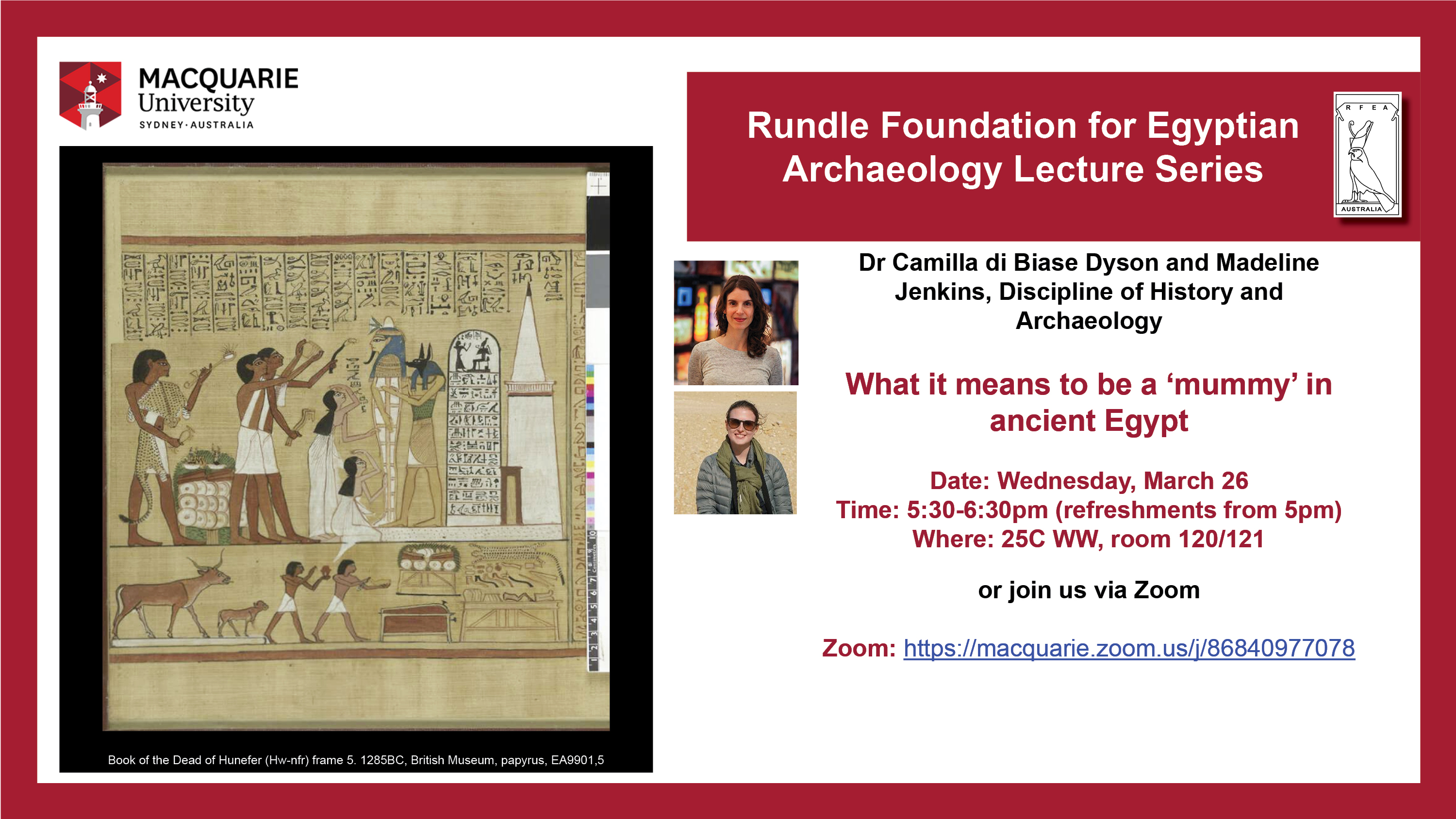
Please join us on Wednesday, March 26 for the next presentation in the 2025 Rundle Foundation for Egyptian Archaeology lecture series.
The paper, which is entitled, 'What it means to be a ‘mummy’ in ancient Egypt', will be presented by Dr Camilla di Biase Dyson, Senior Lecturer in History and Archaeology at Macquarie University, and PhD student, Madeline Jenkins, also in the Discipline of History and Archaeology. Professor Ronika Power, Professor of Bioarchaeology at Macquarie University, will chair the session and give a response on the basis of her own current research (with colleagues at Chau Chak Wing Museum and Macquarie University) on the topic.
Time: 5:30-6:30pm (refreshments from 5pm)
Where: 25C WW, room 120/121
Zoom: https://macquarie.zoom.us/j/86840977078
Abstract: Thanks to the advances in science (residue and biomedical analyses) and technology (CT-scanning, MRI), we know more about mummification than ever before. But what about what the Ancient Egyptians thought mummies were? This paper takes a deep dive into the words and ideas surrounding mummies in ancient texts to try to reconcile whether the ancient ideas have any similarities with what we know now. We found that the differences are even bigger than we thought they would be, and, on that basis, we make some suggestions for how scholars could translate the word sꜤḥ (ostensibly 'mummy'). In this way, we can consider what kinds of practical contributions word studies can make to current issues in the heritage sector and beyond.
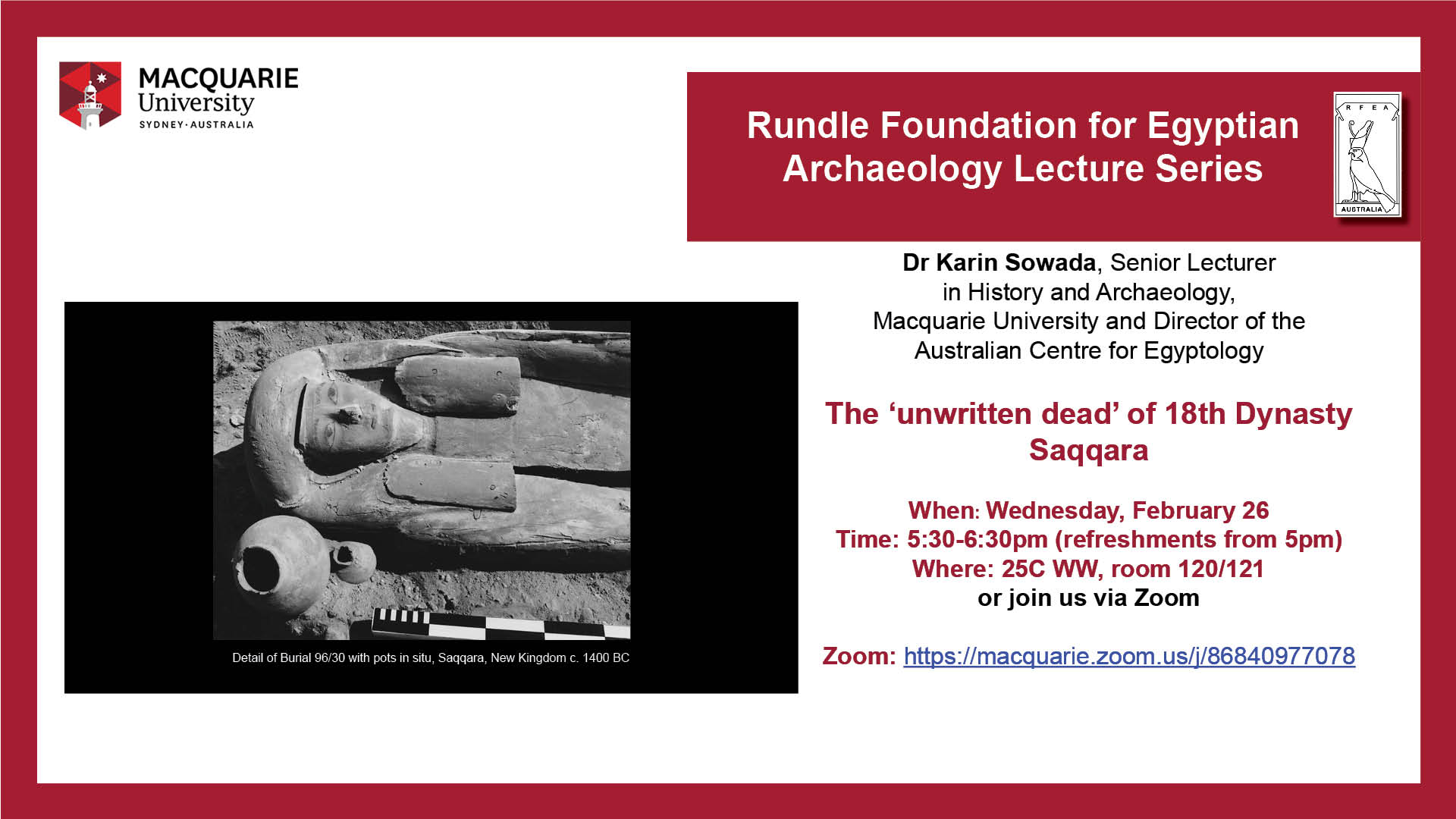
Please join us on Wednesday, February 26 for the first presentation in the 2025 Rundle Foundation for Egyptian Archaeology lecture series. The paper will be presented by Dr Karin Sowada, Senior Lecturer in History and Archaeology, Macquarie University and Director of the Australian Centre for Egyptology, and is entitled: The 'unwritten dead' of 18th Dynasty Saqqara.
Time: 5:30-6:30pm (refreshments from 5pm)
Where: 25C WW, room 120/121
Zoom: https://macquarie.zoom.us/j/86840977078
Abstract: Nearly 30 years ago, a unique find was made at Saqqara by an Australian Centre for Egyptology team lead by Prof. Naguib Kanawati. A large cemetery of modest burials, many dated to the mid-18th Dynasty (c. 1400 BC), exposed a snapshot of the Memphite population from this time.
Relative to elite cemeteries, the burials of ordinary Egyptians have received far less attention over many decades. Owing to the clarity of the stratigraphy, the variety of burial customs, well-preserved human remains, and the tight dating of the material, the cemetery was an unparalleled opportunity to study a population cohort of nearby Memphis from the mid-18th Dynasty. Many carved and decorated coffins were well-preserved, but there were few inscriptions telling us the names and role of their occupants. The character of the material suggesting a lower stratum of society, with some unusual characteristics in the burial preparations and use of the cemetery landscape. Thanks to a grant from the White Levy Program for Archaeological Publications, the cemetery is finally being prepared for publication.
News
Ramses: golden treasures of the superstar pharaoh come to Sydney
What was Egypt like 3,300 years ago? You had to be there! And thanks to a new blockbuster exhibition at the Australian Museum, you can be. Read more about this exciting exhibition in The Lighthouse or view the video.
Secrets of the ancient Nile the subject of a new expedition
Dr Tim Ralph from Macquarie University’s School of Natural Sciences will join an international team on a field expedition to Egypt in December to investigate previously unknown former Nile River branches near the ancient Meidum Pyramid Complex, which is more than 4000 years old. Read more about this in The Lighthouse.
Silver in Ancient Egypt
Surviving tomb robbers and time, jewellery owned by ancient Egyptian royalty in around 2600 BC is helping shed new light on the beginnings of the globalised world.
Read the full ABC article, featuring the study's lead author Karin Sowada, director of the Australian Centre for Egyptology at Macquarie University.
Multidisciplinary discovery of ancient restoration
Read more about this publication
Macquarie researchers have used cutting-edge medical technology to reveal a previously unknown method of preserving Egyptian mummies.
A world-first discovery at Macquarie University published today challenges what we know about ancient Egyptian mummification and raises questions about mummified bodies held in collections worldwide.
A team led by Dr Karin Sowada, a research fellow at Macquarie’s Department of History and Archaeology, examined the layers encasing a mummified adult woman kept at the Chau Chak Wing Museum at the University of Sydney, using advanced CT scans (computed tomography).
3D visualisation and cross-sectional scans revealed a carapace, or shell, encasing the body made from mud and straw sandwiched between layers of linen. Typically, this shell is made from resin, an imported material at the time.
“Mummified bodies in collections all over the world have been sitting right under our noses for generations. The application of new technology can reveal totally new information which challenges what we previously knew,” Sowada says.
The family likely organised a mud carapace as a form of ancient conservation to assist her transition to the hereafter.
Mummification is the process used to preserve the dead by drying and embalming, practiced widely in many ancient cultures. Archaeologists had not recorded the use of mud carapaces within layers of textile wrappings as a technique in Egyptian mummification before now.
Sowada was involved in conducting initial scans on the mummified body in 1999 during which the carapace was first discovered. Nearly two decades later, working with radiologist Professor John Magnussen, bio-archaeologist Professor Ronika Power and the museum’s senior curator Dr James Fraser who initiated the project, she analysed new CT scans.
“The technology has improved enormously for medical purposes. And so the new visualisations of the wrapped body are incredibly good, many times better, than in the late ‘90s,” she says. “We can see so much more detail.”
In a CT scan, radiologists use computerised X-ray imaging creating a narrow beam of X-rays around the body or object to produce cross-sectional images. Improved computing enhances analysis of scans, enabling better visualisation of what lies beneath the wrappings.
Conservation or imitation?
Dr Timothy Murphy, a geochemist at Macquarie, helped determine that the carapace consisted of a thin base layer of mud, coated with a white calcite-based pigment and a red-painted surface of mixed composition.
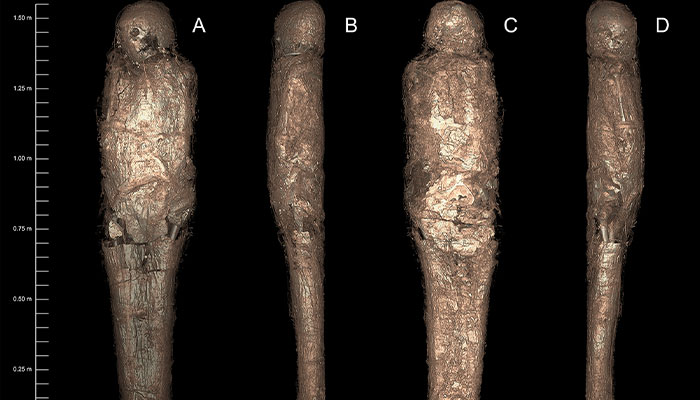
In the detail: 3D-rendered CT images of the mummified adult woman. 21st-century medical technology allows 'incredibly good' visualisations. Photo credit: Chau Chak Wing Museum and Macquarie Medical Imaging.
Previously, researchers had discovered resinous paste and linen shells within mummy wrappings through autopsies and radiological imaging. Yet such shells are little studied and usually assumed to be made of resin, based on comparison with bodies of the Egyptian elite.
Ancient Egyptians believed that mummification helped transition the deceased from death to the afterlife and rebirth, Sowada says. “Some of the bones had separated from each other, damage probably caused by ancient tomb-robbers. The family likely organised a mud carapace as a form of ancient conservation to assist her transition to the hereafter.”
Another hypothesis is that the mud carapace is an example of 'elite emulation'. The deceased’s family may not have been able to afford the expensive resin which was used by Egyptian elite classes and imported from the Mediterranean coast, so they used cheaper, readily available mud – probably from the nearby Nile.
“Even today, when the rich and famous decide to do something it often sparks a fashion trend that percolates down to the rest of society who try to copy it,” Sowada says.
The mystery mummy
The research team also partnered with Dr Geraldine Jacobsen and her team at ANSTO (Australian Nuclear Science and Technology Organisation) to radiocarbon date the linen wrappings. The ANSTO team discovered the wrappings date to the 12th century BC, around 3200 years ago. This led to another puzzling discovery.
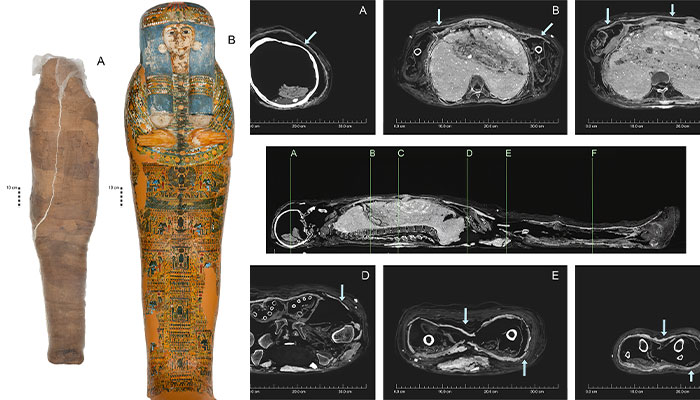
New views: The mummified woman, encased in a modern sleeve for conservation, and its coffin (left) and CT images showing transverse views of the carapace at different locations. Photo credit: Chau Chak Wing Museum and Macquarie Medical Imaging
“Carbon dating revealed a discrepancy of 150-200 years between the date of the mummified person and its coffin,” Sowada says. “Based on the decorative style, the coffin dates to about 1000 BC. The results indicate that the body is older than the coffin and does not belong to it.”
- In Kamala's footsteps: a girls' guide to making it to the top
- Revealed: the best trees for shading Sydney school yards
The inscription on the wooden coffin names the original occupant as the lady Meruah, ‘Mistress of the House’, ‘Chantress of Amun’ and ‘Adorant of Mut in Isheru’. Mut was the consort of the god Amun and Isheru is the ancient name given to part of her temple at the Karnak complex in ancient Thebes.
Sowada says these titles suggest the original person in the coffin was a married woman of relatively high status.
The coffin and the associated body were part of a collection by philanthropist and politician, Sir Charles Nicholson, who donated it to the University of Sydney in 1860 after he bought it during a trip to Egypt a few years earlier.
“Perhaps, the dealer who sold it to Nicholson just rustled up a mummified body from another source to fill the empty coffin. The dealer probably thought a tourist wasn’t going to know the difference,” Sowada says.
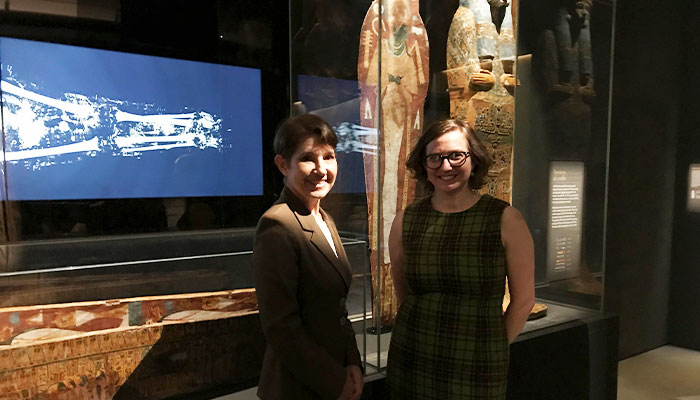
Dr Karin Sowada (pictured with Candace Richards, Acting Curator of the Nicholson Collection) is a specialist in the archaeology of Egypt and the Middle East, and Research Fellow in the Department of History and Achaeology.

